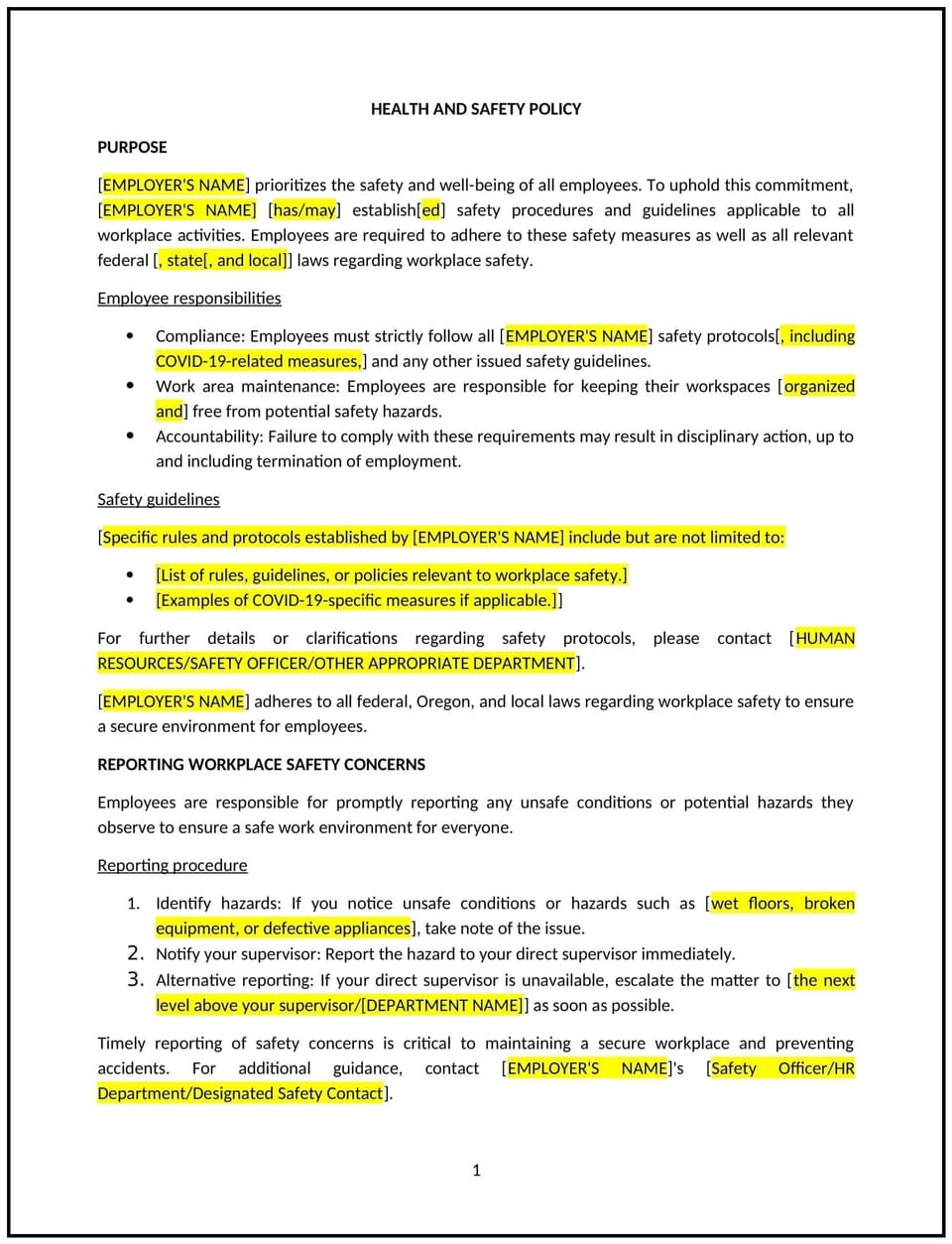Health and safety policy (Oregon): Free template

Health and safety policy (Oregon)
This health and safety policy is designed to help Oregon businesses establish guidelines for maintaining a safe and healthy workplace. It outlines procedures for identifying hazards, preventing accidents, and complying with Oregon’s Occupational Safety and Health Administration (OSHA) standards.
By adopting this policy, businesses can protect employees, reduce workplace injuries, and align with legal requirements for workplace safety.
How to use this health and safety policy (Oregon)
- Identify workplace hazards: Conduct regular risk assessments to identify potential hazards, such as unsafe equipment or hazardous materials.
- Establish safety procedures: Outline steps for preventing accidents, such as providing protective equipment or implementing safety training.
- Address emergency preparedness: Provide guidelines for responding to emergencies, such as fires, chemical spills, or medical incidents.
- Train employees: Educate staff on safety procedures, hazard reporting, and emergency response.
- Monitor compliance: Regularly review workplace practices to ensure adherence to the policy and OSHA standards.
- Update regularly: Assess the policy annually to align with evolving business needs and safety regulations.
Benefits of using this health and safety policy (Oregon)
This policy offers several advantages for Oregon businesses:
- Protects employees: Ensures a safe and healthy workplace, reducing the risk of injuries or illnesses.
- Reduces liability: Demonstrates a commitment to workplace safety, minimizing legal and financial risks.
- Aligns with legal standards: Promotes compliance with Oregon OSHA regulations.
- Enhances productivity: Reduces downtime caused by workplace accidents or injuries.
- Builds trust: Shows employees that the business prioritizes their safety and well-being.
Tips for using this health and safety policy (Oregon)
- Communicate the policy: Share the policy with employees and include it in the employee handbook.
- Provide training: Educate employees on safety procedures, hazard reporting, and emergency response.
- Conduct regular inspections: Identify and address potential hazards through routine workplace inspections.
- Monitor compliance: Regularly review workplace practices to ensure adherence to the policy.
- Update regularly: Assess the policy annually to align with evolving business needs and safety regulations.
Q: How does this policy benefit businesses?
A: This policy helps businesses protect employees, reduce workplace injuries, and align with Oregon OSHA standards.
Q: What types of hazards should businesses address?
A: Hazards may include unsafe equipment, hazardous materials, ergonomic risks, or environmental factors.
Q: How often should businesses conduct safety training?
A: Businesses should provide initial training for new employees and refresher training annually or as needed.
Q: What should businesses do if an accident occurs?
A: Businesses should provide immediate medical attention, investigate the cause, and take corrective action to prevent future incidents.
Q: How often should businesses review this policy?
A: Businesses should review the policy annually or as needed to align with evolving business needs and safety regulations.
This article contains general legal information and does not contain legal advice. Cobrief is not a law firm or a substitute for an attorney or law firm. The law is complex and changes often. For legal advice, please ask a lawyer.


